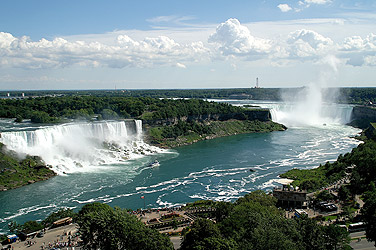News
UB experts weigh in on Wallenda walk

Nik Wallenda’s upcoming wire-walk across Niagara Falls has attracted lots of interest from all over the world.
- By PATRICIA DONOVAN
- Published: May 31, 2012
On June 15, high-wire artist Nik Wallenda will attempt to cross Niagara Falls on a tightrope—the first such attempt in more than 100 years.
He will use an 1,800-foot long, custom-made, two-inch wire that will stretch from Goat Island on the American side of the falls to a site just below the falls on the Canadian side. The wire will be strung about 200 feet above the base of the Niagara Gorge.
The walk poses considerable danger to Wallenda from such things as the falls’ mist plume, changeable winds, possible attack by peregrine falcons as he traverses their flight path and clamps on the safety harness he is being forced to wear by ABC, which is televising the event.
This event has generated much excitement and controversy, and UB experts talked to the UB Reporter about the nature of such spectacles, their role in popular culture, the Niagara mist plume, crowd psychology and the kinds of risks involved in this venture.
- A spectacle with possible violence
- Falls’ water plume, wind could affect safety
- Walk entails different kinds of risk
- Public appeal of walk has psychological underpinnings
- Many people enjoy the physiological arousal they experience when watching dangerous, exciting and novel events, and the Wallenda walk offers danger, excitement and novelty.
- There is some evidence that people who rate higher on sensation-seeking scales prefer arousing media. “In general, men tend to rate higher in sensation seeking and may be more likely to enjoy watching a thrilling or dangerous event like the Wallenda walk,” Pailler says. “The walk also involves voyeurism, and we know how people enjoy watching other people’s lives and activities”—this accounts for some of the popularity of reality TV.
- The danger and uncertainty of the outcome intensifies the experience and, if the walk is successful, there is also the vicarious sense of relief and accomplishment—similar to the experience of watching your favorite team win a game.
- The Wallenda walk is outside the realm of day-to-day experience. “It provides an appealing escape from the mundane,” she points out. “Many of us have detailed memories of watching significant and novel events like the moon landing. And as I said, the potential for danger may heighten this feeling.”
- There is often a satisfying sense of shared experience that accompanies watching such things with others—things that may collectively be recalled and recounted.
- Possible falcon attacks pose safety risk
From the popularity of reality TV to our tendency to slow down to rubberneck at car accidents on the highway, our society loves a spectacle, particularly if it includes the possibility of violence, says David Schmid, associate professor in the Department of English. “This is especially true for those who want to be famous or are attracted to celebrity. More than ever before, fame means to be visible, to do something that grabs public attention and keeps it,” Schmid says.
“Because the tightrope walk by Nik Wallenda touches upon all these themes, public interest in it extends far beyond morbid curiosity. The Wallenda event also has that X-factor that sets it apart from so much on the contemporary media landscape: unpredictability.
“Despite the ubiquity and popularity of so-called ‘reality TV,’ the vast majority of it is so safe, scripted and managed that any element of risk or unpredictability has been entirely removed,” he notes. “This falls walk, on the other hand, is real ‘reality’ television that presents a genuinely chancy, dangerous spectacle on live TV, a performance that could actually lead to the actor’s death. That fact makes us nervous. It also compels us to watch.”
Schmid points out that Suzanne Collins, author of the best-selling ‘Hunger Games’ books, presents the premise in which, in a future United States, children kill each other as part of an immensely popular televised game.
“At first glance, that seems completely unbelievable. But consider the success of the books and the movie adaptation, and the excitement the Wallenda walk is generating. Collins has struck a nerve,” he says.
Wallenda will be walking over a portion of the Niagara Gorge directly below Niagara Falls on the Canadian side. The location is not the safest route he could have chosen and, in fact, it is probably the worst place to cross, according to Marcus Bursik, professor in the Department of Geology.
“There is a plume of mist that rises from the pool of water in the Niagara Gorge just below the falls that produces a moist updraft. It will be a little like walking a tightrope in a mini-thunderstorm. If he is used to moist updrafts, of course, it may not be a problem for him,” Bursik says.
He explains that the size and height of the plume will depend on meteorological conditions that day. “It’s all super-sensitive to small temperature differences. If the water is colder than the air, as it is in the summer months, there is no or little plume and the air will be blowing down-gorge instead. At certain times of the year, the water is warmer than the air, which results in a plume that can rise up to 3,500 feet. The warmer the water is than the air, the bigger the plume will be,” he says.
The wind will be a factor as well. “The wind can be, and often is, stronger than the up or downdrafts associated with the falls. From our measurements, we found that the wind is often blowing across the gorge, so he could get a head or tail wind, or even shear. The plume adds an extra vertical component to a wind that in most places is much weaker than the horizontal wind,” Bursik says.
“Wallenda will have factored possible conditions into his consideration of the walk, of course. He must be used to dealing with different kinds of wind conditions. The plume will be relatively small at this time of year, possibly nonexistent, because air temperatures are warmer than the water. It presents a possible risk, however. Since his wire will be only 220 feet above the gorge basin, even a small plume could increase risk.”
Wallenda’s walk over Niagara Falls entails a variety of risks, says Cristian-Ioan Tiu, assistant professor in the School of Management.
“The first kind is enterprise risk. This is the risk that the whole ‘adventure’ won’t happen for reasons such as regulations, last-minute concern from authorities, etc. I assume that there has been work dedicated to ensure that this event will happen, so the risk here is low,” Tiu says.
“Second is specific risk. In this case, danger could be increased by weather, mechanical complications or health issues. I am no professional wire walker, but I assume that the training and accurate weather reports predict most of these risks and pose appropriate responses.
“Finally,” he says, “there is uncertainty or unquantifiable risks. For example—and I hope not to jinx the guy—the walker cannot prepare for such things as a kid flashing a laser pointer, a helicopter flying too close or someone falling in the water, but they might increase his risk. In fact, however, these are poor examples. What I mean by uncertainty is something for which it is completely impossible to plan.
“I have described these risks from the perspective of the walker,” Tiu says. “From the perspective of the viewer, the risk will appear greater, partly because what is quantified above as specific risk—that is, a risk that can be managed—will be perceived by the viewer, who is not a rope walker, as uncertainty.
“The greater the difference in perception, the more interesting the show will be.”
Sensation seeking, vicarious thrills, danger and uncertainty: Because of our psychological makeup, Wallenda’s walk across Niagara Falls fascinates us on a variety of levels, says Megan E. Pailler, director of the Psychological Services Center in the Department of Psychology.
“In many ways, its appeal is similar to that of arousal-inducing action or horror media,” Pailler explains. “As in those cases, the terms applied to the walk are ‘dramatic,’ ‘thrilling’ and ‘exciting.’ But why is this particular event so electrifying?” She offers several reasons:
The Canadian Peregrine Foundation has raised concern over the possibility of attacks on Wallenda by a pair of peregrine falcons nesting in a nearby decommissioned Ontario Power Generation plant. The foundation says the birds could feel threatened by Wallenda, since his walk will take him through their flight path.
“Peregrines are aggressively protective of their territory, particularly when they are caring for their young, and in this region this is the time of year when they are doing just that,” says Christopher Hollister, associate librarian in the UB Libraries and an avid conservationist and ornithologist. “There are countless stories of peregrine falcons diving-bombing people.
“I do think that possible falcon attacks should be a serious consideration in terms of his safety,” Hollister says. “Peregrines reach speeds of 200 miles per hour during a hunting swoop, making them the fastest animal on the planet. Being hit by a bird moving at that speed would have quite an impact on a man trying to balance on a high wire.”






Reader Comments